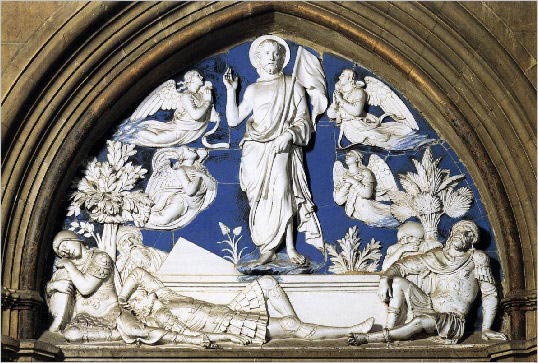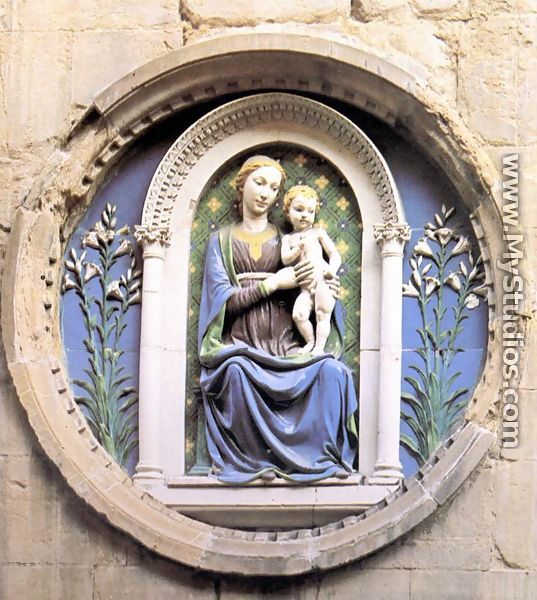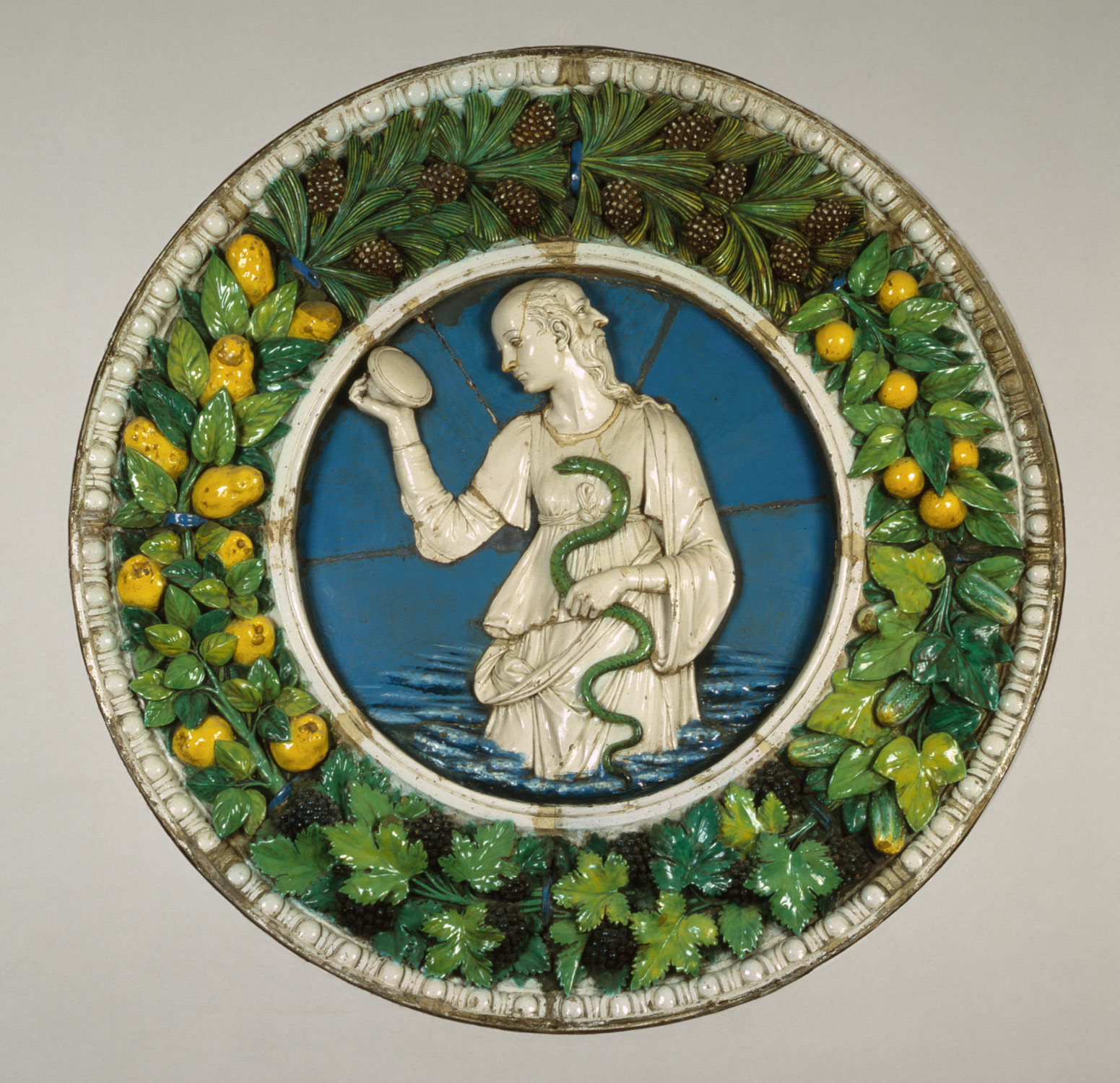Museum of Fine Arts, Boston August 9–December 4, 2016,
National Gallery of Art in Washington from February 5–June 4, 2017.
Powerful expressions of faith, hope and love are manifested in brilliant colors that characterize the Della Robbia glazed terracotta sculptures from the Renaissance, explored in an exhibition organized by the Museum of Fine Arts, Boston (MFA). Della Robbia: Sculpting with Color in Renaissance Florence is the first major exhibition in the US dedicated to Della Robbia sculptures, which have endured for more than 500 years. Their shine and colors, including deep cerulean blues and opaque whites, remain unchanged from the time of their creation—a lasting testament to Renaissance ingenuity.
Florentine sculptor Luca della Robbia (1399/1400–1482) invented the groundbreaking glazing technique in the 15th century, and the exhibition showcases 46 works of art by his family and associated workshops.
The Visitation (about 1445, Church of San Giovanni Fuorcivitas, Pistoia), an extraordinary masterpiece, is one of six important loans from Italy that have never been seen in the US before.
The Brooklyn Museum’s lunette of the Resurrection of Christ (about 1520–24) is presented at the MFA following a year-long conservation project—one of several undertaken for the exhibition.
The Della Robbia family workshop flourished in Florence for about a century, producing expressive artworks for all spheres of life. Luca della Robbia created his glazed terracotta technique in the 15th century, and it was immediately recognized and celebrated as a new invention. He shared its secrets with his nephew and principal collaborator Andrea della Robbia (1435–1525), who in turn passed them on to his sons Giovanni (1469–1529/30), Luca the Younger (1475–1548), Marco (1468–1534), Francesco (1477–1527/28) and Girolamo (1488–1566). Portraying both sacred and secular themes, Della Robbia sculpture gained a strong presence in public spaces—from street corners to churches—and private homes.
“Della Robbia sculpture is a quintessentially Florentine Renaissance art form, one that seems to transport us to the 15th-century city,” said Marietta Cambareri, Curator of Decorative Arts and Sculpture and Jetskalina H. Phillips Curator of Judaica, Art of Europe, who organized the exhibition. “Praised in its own day as ‘almost eternal,’ and seen as a new invention not known in antiquity, Luca della Robbia’s technique of glazed terracotta displays the creative ingenuity and graceful beauty that characterized the Renaissance and that continues to astonish and beguile us today.”
The exhibition begins with works made for domestic settings, exploring notions of hope and prosperity for one’s city and family. Della Robbia sculpture was often acquired to mark significant family events such as marriages and births, and the objects became part of the lives and histories of their owners.

Giovanni della Robbia’s brightly colored lunette of the Resurrection of Christ (about 1520–24, Brooklyn Museum) once adorned the upper section of a garden gate in the Tuscan villa of the Florentine Antinori family, who commissioned it in the early 16th century. The family’s coat of arms marks the lower corners of the 11-foot-wide relief, and the Marchese Antinori—possibly Niccolò or his son Alessandro—is prominently shown praying before the resurrected Christ. The sculpture is composed of 46 separate pieces and underwent a year-long conservation treatment in preparation for the exhibition, with generous support from the current generation of the Antinori family. The relief, now restored to its original splendor, has not left Brooklyn since it was donated to the museum in 1898.
Portrait busts were also popular in Florentine Renaissance homes. Bust of a Young Boy (about 1475, Museo Nazionale del Bargello) offers a touching example of naturalism, expressed through the child’s fleeting expression and parted lips that convey a sense of living breath. Like other contemporary portrayals, the work illustrates a new Renaissance interest in capturing the individuality of children. Naturalistic representation using the Della Robbia technique is also demonstrated in Virgin and Child with Lilies (about 1460–70) from the MFA’s collection, in which the baby Jesus acts like a real child, turning away from his mother to reach for the lilies, the figures seated on a grassy meadow of flowers.

The extraordinary loan of Luca della Robbia’s The Visitation (about 1445)—his masterpiece in the medium he invented—travels to Boston from the church of San Giovanni Fuorcivitas in Pistoia, shown in the US for the first time. The sculptural group of two figures anchors the second section of the exhibition, which highlights expressions of love—especially the bond between mother and child. It presents an intensely moving interaction between Mary, pregnant with Jesus, and her elderly cousin Elizabeth, who is pregnant with John the Baptist.
The Visitation was widely reproduced in the 20th century—there were at least six casts in American collections by 1910, including one in the Renaissance cast gallery at the MFA’s original Copley Square building. The work also attracted at least one American artist of the time—John Singer Sargent made a sketch of the sculpture, probably from the original group in Pistoia.
Across from The Visitation,
the Nativity with Gloria in Excelsis (about 1465–70) from the MFA’s collection shows a newborn Jesus at the heart of the composition, framed by Mary and Joseph, both of whom are kneeling. Their poses signal their recognition of the child’s holiness and provide models of prayer for worshippers. Angels hold a musical staff with the words “Gloria in excelsis Deo (Glory to God in the highest),” the opening to a hymn sung during Mass.
Several Madonna and Child reliefs, by far the most common form of domestic sculpture in the Renaissance, are on view. Particularly fine examples come from the Detroit Institute of Arts, the National Gallery of Art and the Museo Nazionale del Bargello, Florence. These reliefs share exemplary technical quality, affective expression and the power to inspire devotion.
Two versions of Luca della Robbia’s Madonna of the Niche shown side by side,
one from the MFA (about 1445–55)
and one from the Metropolitan Museum of Art (about 1445–55), depict a tender moment between Mary and Jesus, with the baby leaning into his mother’s body, her left hand wrapping around him and her right hand clasping his right foot as if to keep him from stepping too far.
The important loan of a relatively unknown work by Luca, the large-scale Madonna and Child (about 1450–60) from the Oratory of San Tommaso Aquino in Florence, demonstrates his mastery of a wider range of colors than the classic blue and white, showing that his primary use of the two colors in other works was an artistic choice. Conservation of the piece was funded by Friends of Florence, a US nonprofit organization dedicated to preserving and enhancing the cultural and historical integrity of the arts located in the city and region of Florence.
Andrea della Robbia generally followed his uncle’s choice of blue and white, but his Mother of Sorrows (about 1525, Saint Louis Art Museum) demonstrates his exploration of an expanded palette to enhance the emotion expressed in the face and mourning gesture of Mary. The sculpture, meant to evoke a sympathetic response, is thought to be part of a group that included the body of Jesus as the focus of Mary’s grief.
A monumental piece by Andrea della Robbia, Prudence (about 1475), a personification of one of the cardinal virtues, features an abundance of greens and yellows in a particularly impressive garland filled with grapes, pinecones, cucumbers, lemons and a variety of other fruits. The roundel has been restored by conservators at the Metropolitan Museum of Art, who have reconfigured the garland based on its original sequence, discovered during the project.
In addition to further experimentation with color, other works show the Della Robbia leaving sections of clay unglazed. The flesh of both Mary and Jesus represented in Giovanni della Robbia’s Pietà (about 1510–1520, National Gallery of Art) is rendered in unglazed terracotta, making the sculpture less brilliant in appearance and thereby more somber and appropriate for its religious function, helping to inspire contemplation.
Expressions of faith are further explored in the exhibition’s final section, which also showcases development of the glazed terracotta technique beyond the Della Robbia family, featuring several works by a rival workshop established around 1480 by the sculptor Benedetto Buglioni (1459/60–1521). While one Renaissance account claims that a woman working in the Della Robbia home and shop leaked trade secrets to Buglioni, it is more likely that he actually trained with the Della Robbia before establishing his own business.
Santi Buglioni (1494–1576) was a distant relative of Benedetto, who trained Santi in the art of glazed terracotta, adopted him and left him his workshop. Three of his nearly life-size preaching saints are gathered in the exhibition—Saint Bernadino of Siena (about 1550, private collection), Saint Francis (about 1550, Uffizi Gallery in Florence) and Saint John of Capistrano (about 1550, Los Angeles County Museum of Art). The large-scale figures combine unglazed clay with colored glazes, and their size clearly tested the limits of the material—large cracks are evident in all three of them. Produced about 20 years after Giovanni della Robbia’s death, when Santi Buglioni’s shop was the only one in Florence still creating works in glazed terracotta, the preaching saints stand as the swan song of the disappearing technique, among the very last works to employ it in the Renaissance.
Also in this section is the MFA’s St. John the Baptist (about 1505–15) by Giovanni Francesco Rustici, an artist who did not specialize in the Della Robbia technique, but sometimes adopted it for expressive purposes. He likely relied on a member of the Della Robbia workshop to glaze the sculpture, which displays a distinctly creamy color—an experiment that emphasizes the highlights and shadows of the modeled clay and recalls the experimentation with traditional techniques that characterized the work of Rustici’s friend and mentor, Leonardo da Vinci.
While the Della Robbia workshop in Florence essentially dissolved around 1530, Girolamo della Robbia continued to produce sculpture in France, creating works for King Francis I, who favored the most up-to-date Italian styles. A series of Girolamo’s busts, meant to be set into roundels, is on view in the exhibition, including his 1529 portrait of Francis I, King of France, on loan from the Metropolitan Museum of Art. It is the only identifiable independent portrait of a known sitter by a member of the Della Robbia workshop.
The use of glazed terracotta declined in the 16th century, as marble and bronze became the preferred materials for sculpture, but the medium experienced a renaissance during the 19th century. Isabella Stewart Gardner, for example, acquired two Della Robbia works in the process of furnishing her Venetian-style palazzo in Boston. One of them, a Sacramental Tabernacle (1470s, Isabella Stewart Gardner Museum) attributed to Andrea della Robbia, is on view in the exhibition.
American collectors who could not locate or afford original Della Robbias instead bought fine reproductions, made in Florentine ceramic factories that had developed a technique that mimicked the pure, opaque colors and hard, shiny surfaces characteristic of the original Renaissance works. The Virgin Adoring the Child (about 1910), modeled after a work by Andrea della Robbia, was made by the Cantagalli workshop in Florence and purchased in Italy around 1912 by a family in Massachusetts.
Della Robbia Materials and Technique
Recent technical research by scholars and conservators working on Della Robbia: Sculpting with Color in Renaissance Florence, including at the MFA and other institutions, has shed new light on the Della Robbia technique, which shows a profound understanding of the clay medium and inventive adjustment to the composition of the glazes. The raw, calcium-rich clay was gathered from Arno riverbeds and then carefully refined to make it especially suited for glazing—a process that optimized the fit between clay and glaze, minimizing flaws in the surface. After the sculptures were formed by hand-modeling or through the use of molds, they were placed into a kiln for an initial firing. Once the ceramic body had cooled, the glazes—prepared using the Della Robbia’s secret recipe—were applied and the work was fired again. The recipe involved greater percentages of lead and tin, which enhanced the opacity and brilliance of the glazes. Larger sculptures, such as the Resurrection of Christ, were manufactured in sections to facilitate firing in the kiln—as well as permit safe handling and export of the sculptures from Florence to locations throughout Europe. Today, survival of the sculptures’ vibrant glaze colors testifies both to the durable nature of the materials and the Della Robbia workshop’s unrivaled technical expertise.
Della Robbia Reproductions in Boston
Countless reproductions of the best-known Della Robbia sculptures were produced in the 20th century in a wide variety of material—including plaster, mosaic and concrete, as well as glazed terracotta—and repurposed in a range of both indoor and outdoor settings. Many can be seen around Boston. Beyond the exhibition, Boston residents can see a version of Luca della Robbia’s lunette of the Madonna and Child with Angels decorating the portal of St. Mary of the Assumption School in Brookline. Buildings owned by the Brigham and Women’s Hospital—formerly known as the Boston Lying-In Hospital—and Boston Children’s Hospital also feature roundels based on Andrea della Robbia’s reliefs of swaddled children, which decorated the loggia of the Ospedale degli Innocenti foundling hospital in Florence, designed by Brunelleschi.
Italian Renaissance Sculpture at the MFA
The MFA’s collection of Italian Renaissance sculpture is as old as the Museum itself—the first acquisitions date to 1876, when the Museum opened its doors. Since then, the MFA has expanded its holdings of Italian works from one of art history’s most creative periods (1400–1600). The Museum showcases approximately 90 Italian Renaissance works, primarily sculpture and decorative arts, including Donatello’s marble relief Madonna of the Clouds (about 1425–35). It was bequeathed to the MFA by Quincy Adams Shaw, a wealthy Bostonian with a renowned collection of Italian Renaissance sculpture. Shaw also gave the Museum four Della Robbia works, acquired from Stefano Bardini, a major Florentine dealer. They include three by Luca della Robbia—Nativity with Gloria in Excelsis (about 1465–70), Virgin and Child with Lilies (about 1460–70) and Madonna of the Niche (about 1445–55), all on view in Della Robbia: Sculpting with Color in Renaissance Florence—as well as Virgin and Child (about 1500–25) by Andrea della Robbia, on view in the Italian Renaissance Gallery. In total, the Museum owns 12 works by Luca, Andrea and Giovanni della Robbia and their workshop, as well as two other Renaissance works made using the glazed terracotta technique.
The Antinori Family
Conservation of the Resurrection of Christ by Giovanni della Robbia at the Brooklyn Museum was made possible with generous support from the Antinori family. Now in its 26th generation with sisters Allegra, Alessia and Albiera Antinori all involved in the family-owned wine company, the family has always shown passion for and commitment to the arts. The restoration project is important to the Antinori and continues their legacy of supporting both Renaissance and contemporary art. Masterful works of art commissioned and collected over the centuries by family members are on display at their state-of-the-art Antinori Chianti Classico winery in Florence—among them the Antinori family crest created by Giovanni della Robbia in the early 1500s and contemporary art installations and exhibitions curated by Alessia Antinori over the past decade.
Related Programming
This fall, the MFA offers an array of programming related to Della Robbia: Sculpting with Color in Renaissance Florence. In addition to a two-lecture course on the Della Robbia on September 20 and 27, the Museum hosts the Attingham/Albainey Memorial Lecture on “Della Robbia Sculpture: Renaissance Invention/Modern Rediscovery” on October 16. The MFA will also offer a wide selection of in-gallery programming related to the exhibition. For more information on events and programming, visit mfa.org/programs.
Publication
The exhibition is accompanied by Della Robbia: Sculpting with Color in Renaissance Florence by Marietta Cambareri, with contributions by Abigail Hykin and Courtney Leigh Harris and produced by MFA Publications. In recent years, renewed attention from art historians, backed by sophisticated technical studies, has reintegrated the Della Robbia into the mainstream of Renaissance art history and illuminated their originality and accomplishments. This beautifully illustrated companion to the first major Della Robbia exhibition in the US brings readers into the workshops of these ingenious artists to experience one of the great inventions of the Renaissance and the enduring beauty it captured. The hardcover book (176 pages, 130 color illustrations) is available for purchase in MFA shops and online for $45























